CyberPowerPC's Gamer Xtreme 4000: Now with Sandy Bridge
by Dustin Sklavos on January 4, 2011 12:00 AM EST- Posted in
- Systems
- Intel
- Sandy Bridge
- CyberPowerPC
- NVIDIA
Gaming Performance
The NVIDIA GeForce GTX 570 in the CyberPower 4000 is no slouch, but it's facing tough competition from some of the other desktops we've tested. Keep in mind that the 4000 is also the least expensive desktop (or at least quoted least expensive) in our lineup, though. Starting with the "High" preset we'll see if the i7 can pick up some of the slack here, but we expect the 4000 to generally fall in about the middle of the pack.
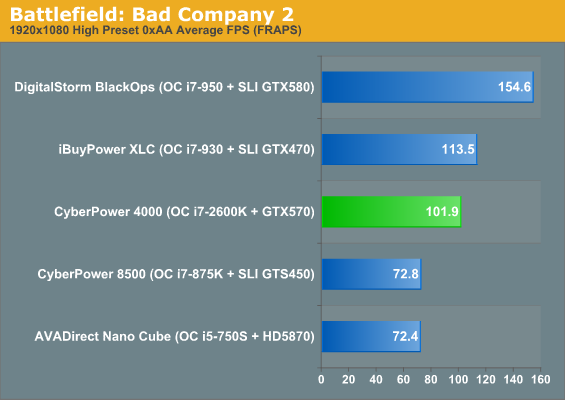

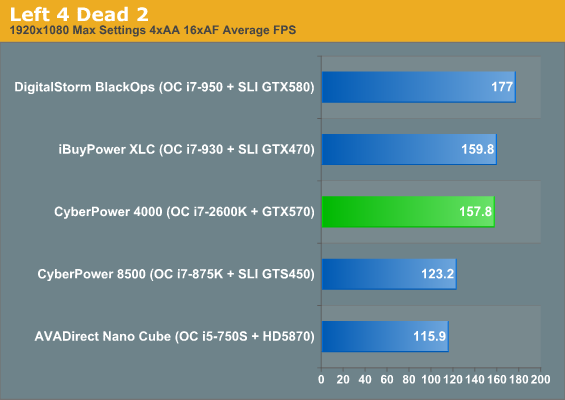
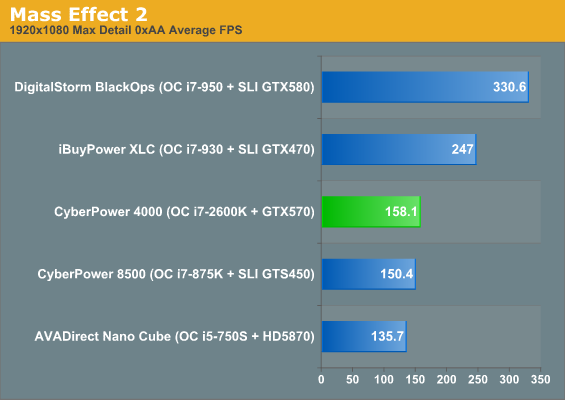

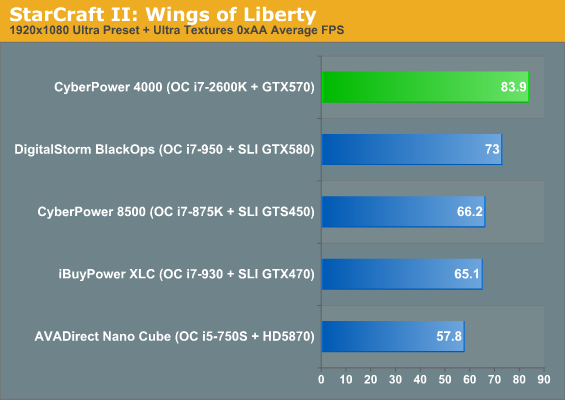
Sure enough, the GTX 570 falls in line squarely where we expected, with the only win going to the notoriously CPU-limited, poorly-threaded StarCraft II. What possessed Blizzard to release a game that only scales up to two cores in 2010, we'll never know. Things should remain consistent when we bounce up to our "Ultra" preset, and hopefully that'll shift enough of the load to the graphics subsystem in StarCraft II to bring it in line.
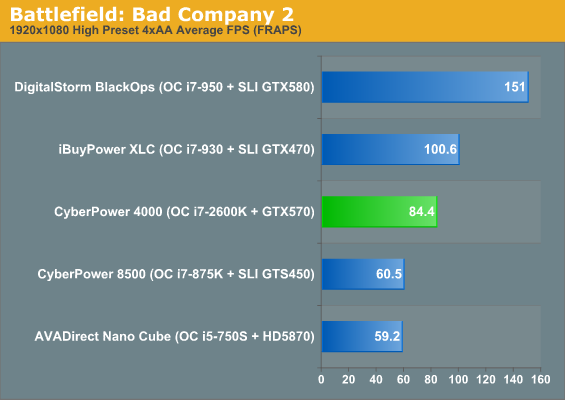
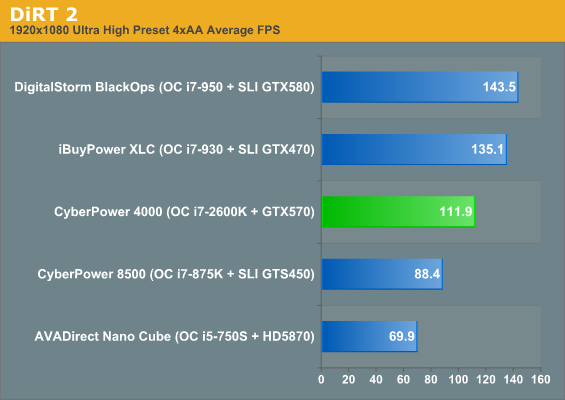
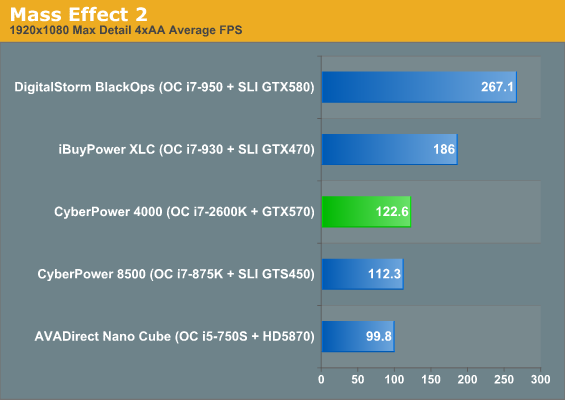

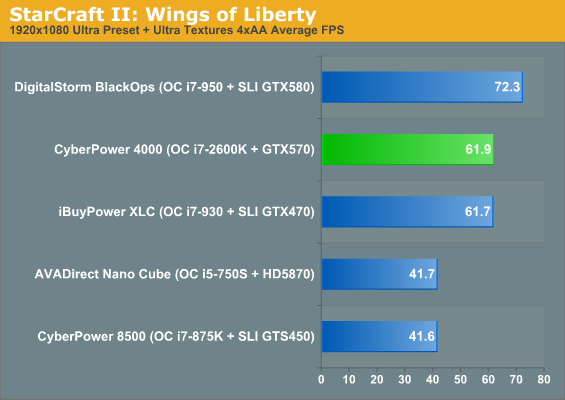
As expected, everything places about where it's supposed to. The comparatively tame 3.5GHz overclock on the iBuyPower XLC is enough to strangle the SLI'd GTX 470s in that build in StarCraft II, but beyond that everything falls into place. Any of these systems are still incredibly fast, though. What we'd like to see is what would happen if a massively overclocked i7-2600K was paired with SLI'd GTX 580s; I had a sneaking suspicion that even a 3.8 GHz i7-950 was still going to be a little bit limiting on a graphics system that powerful, so it would be interesting to see if the 2600K could alleviate that bottleneck.










42 Comments
View All Comments
JarredWalton - Tuesday, January 4, 2011 - link
I believe the overclock applies to all the Turbo modes. So the 4.4GHz is for single-threaded, and you'd get lower than that for dual-core/multi-core operation. Intel didn't specifically list the Turbo states for the desktop chips (see my SNB Mobile article for comparison, where they explicitly list what SC, DC, and QC can Turbo up to), but if they do something similar to the mobile parts then you should still see up to ~4.0GHz even when loading all four cores.JarredWalton - Tuesday, January 4, 2011 - link
Edit: Okay, maybe this is the correct info from a different slide. Intel appears to state that on the desktop CPUs, Max Turbo is +4 bins for SC, +3 bins for DC, +2 bins for TC, and +1 bin for QC. That means if you set the Max Turbo to 4.4GHz, quad-core could still hit 4.1GHz (assuming temperatures are acceptable).Stuka87 - Tuesday, January 4, 2011 - link
Hmm, ok. Still seams a bit confusing the way they have it written. If its +1 but for QC, wouldn't that mean 1 bin up from the base clock? So if you over clocked the turbo from 3.8 to 4.4 thats effectively 600MHz, so 600Mhz over 3.4GHz is 4GHz?JarredWalton - Tuesday, January 4, 2011 - link
Yeah, that's what I'm not sure about. Can you raise the max Turbo for SC/DC/TC/QC separately? I don't think so, but I don't have any desktop hardware so I can't say for sure. It would make more sense to have the DC/TC/QC Turbo be Max - 1/2/3 in my book. I believe there's also some stuff in the BIOS where you can set the thermal/power range on the CPU (Ian mentioned this in the ASRock mobo review I think? Or maybe it was Anand's article....) I guess right now I'm stuck looking for information as well, while I long for SNB hardware other than the notebook I got. :-)cyberpowerpc - Tuesday, January 4, 2011 - link
Just to clarify some concerns regarding the OC:The 4.4 GHz OC is modest for Sandy Bridge. We could have easily shipped a 4.8/4.9 GHz system but feel that we did not want to ship a system with an Overclock that we, in the end, may not support.
Additionally, for the max turbo ratio, you can individually set what the DC/TC/QC turbo. In the review system, the max turbo ratio was set to x44 and that applies to DC/TC/QC.
7Enigma - Tuesday, January 4, 2011 - link
Thank you for the reply, but what you are basically saying is you chose a single (modest) multiplier and put it for all DC/TC/QC values. Why would you choose the same number when the thermals should be vastly different (ie DC multiplier should be significantly higher than the QC multiplier)?I think you just confirmed how basic this "OC" really was.
Stuka87 - Tuesday, January 4, 2011 - link
Thanks for replying. It clears up the question that I had regarding the various turbo speeds.However, why not set the turbo speed for DC to a higher level than TC or QC? It should be easily doable from a thermal standpoint, unless testing showed this to not be true and/or some other issue came up.
I understand not wanting to go too far and then not be able to support it, that makes perfect sense from your point of view. however.
MeanBruce - Tuesday, January 4, 2011 - link
Sandy-M LGA-1055 does seem amazing, yet for those who don't know Sandy-E LGA-2011 is due in July. Native USB 3.0, LightPeak support, the new X-68 chipset, Quad-Channel memory, integrated north bridge, now that's worth waiting 6months for! The enthusiast platform CPU, Mainboard, and Memory, should cost only $200 to $250 more, well worth the investment!JarredWalton - Tuesday, January 4, 2011 - link
I didn't think X68 (or whatever) was slated to get USB3.0, though I haven't really looked into that I admit. LightPeak might be nice though.strikeback03 - Wednesday, January 5, 2011 - link
According to Anand's article, SNB-E won't be until Q4, i.e. October at the earliest http://www.anandtech.com/show/4083/the-sandy-bridg...